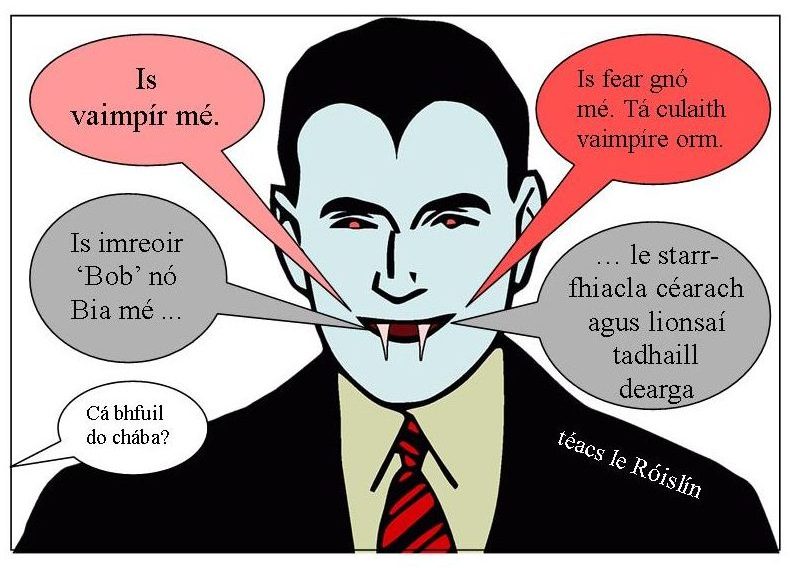To Be or To Wear: Which Irish Verb for Halloween Costumes (agus éadaí go ginearálta) Posted by róislín on Oct 22, 2016 in Irish Language
(le Róislín)

Cén sórt neach é seo? Fíorvaimpír? Gnáthdhuine i gculaith vaimpíre? Fear gnó i gculaith vaimpíre? Imreoir ‘Bob nó Bia’ i gculaith vaimpíre? Gnáthfhear gnó tar éis “Occupy Wall St. na Vaimpírí”? Mainicín do chomhlacht lionsaí tadhaill? (grafaic: https://pixabay.com/en/dracula-vampire-halloween-1226357/)
The Irish language offers two main verbs for saying you are wearing an item of clothing. One is the verb “to be,” combined with the word “on,” essentially saying “A hat is on me,” for “I am wearing a hat.” The second is the verb “caith,” which can literally mean “wear,” but which can also mean “wear out,” “consume,” “spend,” “smoke,” “cast,” or “throw.” And that’s even before such combinations as “caith i ndiaidh” (pine for), “caith anuas ar” (belittle), etc.
I tend to prefer the first one (… a bheith orm, Tá … orm, Bhí … orm, srl.) since there’s less ambiguity. Of course, saying “Tá stocaí orm” (I’m wearing socks), could possibly be construed to mean that some socks happened to fall on my back when I was lying down on my stomach, but common sense would tell us that this is unlikely.
Anyway, let’s look at some examples. And by the way, this is a good round up of verb practice. But we’ll just stick to present, past and future, since these would be the most typical for discussing Halloween costumes.
Tá culaith vaimpíre orm. Bhí culaith vaimpíre orm. Beidh culaith vaimpíre orm.
If we use the “caith” verb, we’d have:
Tá culaith vaimpíre á caitheamh agam. Caithim culaith vaimpíre go minic.
Bhí culaith vaimpíre á caitheamh agam. Chaith mé culaith vaimpíre aréir.
Beidh culaith vaimpíre á caitheamh agam. Caithfidh mé culaith vaimpíre an bhliain seo chugainn.
Of course, there is a third alternative, using the Irish linking verb “is,” or its past tense “ba.” In these cases, you’re not saying you’re wearing a costume; you’re saying you are the character, animal, creature, etc. Some samples are:
Is vaimpír mé. I am a vampire. You could use this to say that you really are a vampire. Or you could mean that your costume shows that you are pretending to be a vampire.
Ba vaimpír mé. I was a vampire. This could be used to say that you dressed up as a vampire for Halloween or that you really used to be a vampire until somehow you got returned to a normal human state.
And actually, there’s a fourth alternative, using forms of the verb “tá” and phrases like “i mo,” “i do,” and “ina,” as connectors. This structure generally indicates a change in status, which seems reasonable, considering how people become vampires. In this case we would have:
Tá mé i mo vaimpír. I am a vampire (implying that you didn’t used to be)
Bhí tú i do vaimpír. You were a vampire.
Beidh sé ina vaimpír. He will be a vampire.
Beidh sí ina vaimpír. She will be a vampire.
For clarification regarding the current/past status, we could have a sentence like
Ba ghnáthdhuine daonna mé ach tá mé i mo vaimpír anois ó bhain Dracula greim asam. I was an ordinary human being but I am a vampire now since Dracula bit me.
By the way, thinking of fangs, fake and actual, it seems to me we’d have two possibilities, contrasting “having fangs” with “wearing (fake) fangs”:
A real vampire (más ann dóibh) would say: Tá starrfhiacla agam. I have fangs.
But a person wearing a vampire costume with fangs would say: Tá starrfhiacla orm, i.e. I’m wearing fangs. They could be “starrfhiacla céarach” (fangs of wax) or “starrfhiacla plaisteacha” (plastic fangs). And yes, there are even “starrfhiacla candaí.” Some are made of a substaint chéiriúil and some are made of cineál guma coganta.
Of course, one could also say “Tá mé ag caitheamh mo starrfhiacla,” but since edible fangs are sold for Halloween, it could mean “I’m consuming my (edible) fangs” or “I’m smoking (!) my fangs.” Or, if the vampire is afflicted with bruxism (I haven’t found an Irish word for that), he could mean, “I’m wearing out my fangs.”
So, there you have the choices:
Tá culaith vaimpíre orm. Tá culaith vaimpíre á caitheamh agam. Is vaimpír mé. Tá mé i mo vaimpír. And so on, for the other tenses.
The first two structures could be used for ordinary clothing as well: Tá hata orm. Beidh cóta mór á chaitheamh agam. Chaith daoine mar Jon Pertwee, Cary Grant, agus Frank Sinatra casóga cois tine.
And what do you think of the fellow in the picture? A real vampire? A ordinary guy in a vampire costume? A business man wearing a vampire costume? A Trick-or-Treater wearing a vampire costume? An ordinary businessman after Vampire Occupy Wall Street? A model for a contact lens company? Do bharúil?
An raibh tusa riamh i do vaimpír (i gcomhair Oíche Shamhna)?
SGF — Róislín
Gluais don phictiúr: bob, trick, prank; cába, cape; céarach, of wax; imreoir, player; lionsa, lens; mainicín, mannequin, tadhall, contact; tadhaill, of contact

Build vocabulary, practice pronunciation, and more with Transparent Language Online. Available anytime, anywhere, on any device.




Comments:
Neasa Níc Dhonaill:
An mhaith, go raibh maith agat 🙂
róislín:
@Neasa Níc Dhonaill Tá áthas orm gur bhain tú sult as, a Neasa.